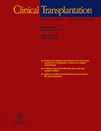Chances and limitations of non-invasive tests in the assessment of liver fibrosis in liver transplant patients
Abstract
Kamphues C, Lotz K, Röcken C, Berg T, Eurich D, Pratschke J, Neuhaus P, Neumann UP. Chances and limitations of non-invasive tests in the assessment of liver fibrosis in liver transplant patients.Clin Transplant 2009 DOI:10.1111/j.1399-0012.2009.01152.x© 2009 John Wiley & Sons A/S.
Abstract: Because fibrosis progression resulting in liver cirrhosis represents the main reason for graft lost in patients after liver transplantation, an early detection of liver fibrosis is crucial. In recent years, several non-invasive tests for the assessment of liver fibrosis have been developed. We prospectively assessed the stage of liver fibrosis of 135 liver transplant patients (94 hepatitis C virus [HCV], 41 alcoholic cirrhosis) using liver biopsy, transient elastography, and serum markers. In the HCV group, the area under the receiver operating characteristic curve (AUROC) for diagnosis of significant fibrosis (F ≥ 2) and cirrhosis (F = 4) was 0.81 (negative predictive value [NPV] = 0.58, positive predictive value [PPV] = 0.9) and 0.87 (NPV = 0.94, PPV = 0.56), respectively. In the alcoholic cirrhosis group, significant fibrosis (F ≥ 2) was diagnosed with an AUROC of 0.83 (NPV = 1.00, PPV = 0.23). In both groups, higher AUROC values were reached in patients with a body mass index of <25 kg/m2, and both serum markers showed no significant correlation to liver fibrosis. The transient elastography is a reliable test for exclusion of liver cirrhosis in HCV transplant and significant liver fibrosis in alcoholic transplant patients. For the diagnosis of significant liver fibrosis in HCV transplant patients, the transient elastography reaches good results but cannot replace liver biopsy. Both serum markers AST-to-platelet ratio index and FIB-4 are not feasible to assess liver fibrosis in liver transplant patients.




